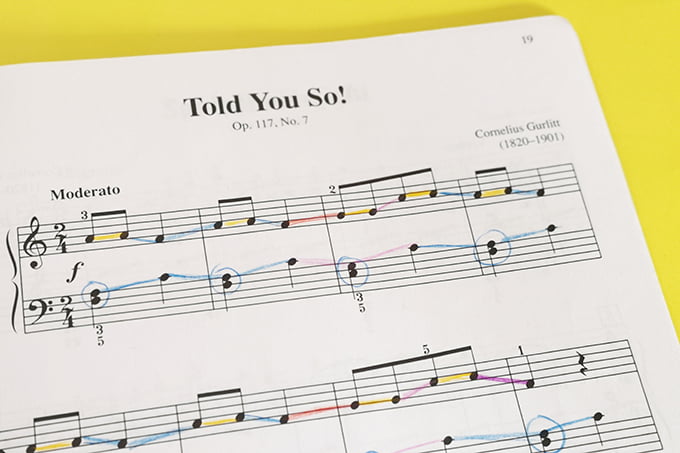When it comes to teaching piano to students who have special needs, I believe we need a flexible toolkit at our fingertips. There’s no one prescription for every student with dyslexia or all kids with ASD.

⬆️ Listen to the podcast above or keep on reading, whichever fits your style. ↙️
In this article, I’ll go through 8 tools I call upon again and again for all sorts of students and give you an idea of when each tends to be most useful.
But first, let’s tackle some language nuances.
Person-First Language
You may have heard the term “person-first language” before. But if you haven’t, it’s the idea of putting the person before the diagnosis. For example, instead of saying, “dyslexic student” you would say, “student with dyslexia”.
This sounds like a nit-picking detail, but it can really make a difference. By putting the person first, you’re implying that their diagnosis is just one thing about them.
Think of it like this. If you had an overbite (as I did until I had surgery to fix it!) would you want to be called an “overbite woman”? Or, if people had to refer to it for some reason, wouldn’t you prefer they said, “woman with an overbite”?
Insert something unique about you into those phrases and I think you’ll see what I mean.
An Exception
I generally try to use person-first language. However, I recently came across a potential exception.
I have learned that some people with physical disabilities prefer the term “disabled people”. The logic (which makes a lot of sense to me) is that they’ve been disabled by society. They are not inherently disabled, it is the built environment in most cases which has disabled them.
This is a nuance and a bit of a tangent but I thought it was worth noting.
For more help teaching piano to students who have special needs, check out that section of Nicola’s Planning Lessons resource page.
Your Neurodivergent Piano Teaching Toolkit
Let’s get back to this notion of putting the student first and take it a step further.
I believe putting the person before the diagnosis can help us rethink how we prepare for students with special needs or learning differences in our piano teaching studios.
As I see it, if we think about the student and treat their diagnosis as just one thing we know about them, it actually makes our lesson preparation more effective.
After teaching many piano students – both neurodivergent and neurotypical – I have come to the realisation that all the potential solutions belong in a flexible teaching toolkit. We can then inform ourselves about which teaching tools are often most useful for students with specific diagnoses…but if the most likely ones don’t work, we still have plenty of widgets left in the box.
Tool 1: Colour
Colour can be used in so many ways in the piano lesson. You may already be using it to mark intervals or highlight dynamics in your students’ written music.
I use colour a lot in my Mini Musicians program and I often borrow from this for other students, too. We use little coloured paddles to mark the piano keys and read from coloured notation to create a gradual progression towards standard notation.

This tool is often useful for students who struggle with pattern decoding. I’ve used colour to teach students with Down syndrome in a way which makes sense to them from day one. You may also find colour especially useful for students with dyslexia, but I would always try the “regular” version of the music first to see whether they really need this extra support.
Tool 2: Simplicity
While colour and little doodles may be useful and engaging for some, it will get in the way for just as many students. 🙃
For students who need more white space on the page and nothing to distract them, I often like to use Piano Pronto as their main reading method. These books have no illustrations and follow a consistent format for most pages so students can focus on the music.
Students with ASD and ADHD will often find a distraction-free approach very helpful. The simplicity will mean that they can hone in on the stuff we actually want them to look at.
Tool 3: Storytelling
If you’re having trouble connecting and engaging with your student, storytelling and analogies can be great teaching tools.
Bring your student into the story by choosing a topic that interests them. For example, if your piano student with ADHD is a big fan of trains and you need him to get to the end of the piece without stopping – you might explain to him how it’s like a train running on a schedule. The train needs to arrive at its destination on time and not get sidetracked along the way.
Some method books which take a story-based approach may be also be useful for teaching piano students with special needs. Wunderkeys, Piano Safari and Tales of a Musical Journey all do a wonderful job of capturing a students’ imaginations using stories.

As with colour coding, storytelling may or may not be a good fit for your student. Some kiddos will simply find the story distracting. Try it out in your lessons and see if your student is less or more focussed on the task at hand using this approach.
Tool 4: Listening
Plopping a book in front of someone and going through it together isn’t the only way to explore music. And when teaching piano to students with special needs, it may shut them out from music altogether.
Taking a listening-first approach to music education should be more obvious than it is. What is music for, after all, if not to listen to?
Some of our students may never read music, and that is fine by me if that’s not the best way for them to learn.
Many, however, actually will learn to read music even if they learn by ear at first. By starting with listening and then associating those patterns they’re hearing with what’s on the page, they can start to make sense of them. I find Rote Repertoire by Samantha Coates fantastic for this as the pieces are highly patterned and designed for this type of approach.
Many students with dyslexia, ASD and ADHD will benefit from listening before reading. Students who don’t have a great aural memory will find this very frustrating, though. I recommend doing some simple echo patterns in your first few lessons to see whether your student has a strong or weak aural memory.
Tool 5: Sensation
Several of the diagnoses we’re talking about here can be associated with hypersensitivity to touch or physical sensations. It only makes sense, then, to explore the sense of touch as a way to teach our students.
- Guide your student to notice how certain patterns or movements feel.
- Have them “go for a ride” by putting their hands on top of yours while you play a piece of music.
- Tap out finger patterns on a table or the closed piano lid before playing them on the piano.
Since coordination can be more challenging for many neurodivergent piano students, focussing on the physicalities of playing in this way can be very helpful.
Tool 6: Rhymes and Words
While some students may be reluctant to speak or sing, for others it is the key to effective learning. You can use the lyrics included in a piece, create your own together or use nonsense syllables to remember tunes and rhythms.
This tool often ends up at the top of my toolkit for students with dyslexia, and some students with Down syndrome too. I’ve found these students often have a great aural memory which they can use to its full potential when we bring speaking and singing into the mix.
Tool 7: Pacing
Playing around with the pacing of your lessons can have a dramatic effect on students’ engagement and attention spans.

Some students will benefit from spending longer chunks of time (5-10 minutes) on each activity, while others will do much better when you do each task for just 1-2 minutes before moving on. Remember that you can always repeat tasks so you don’t need 30 different tasks if you want to do short chunks of time on each!
You might assume that students with ADHD would find a quick lesson pace more effective, but that’s not always the case. Some students with ADHD will actually find the task switching to be the hardest part of the lesson, so you’ll need to test different strategies with each child.
Tool 8: Rude Directions
I think all of us could benefit from making our directions a little more to-the-point or more “rude.” Pretty much all of our students (neurotypical and neurodivergent alike) will do better when we simply say what we really mean.
By taking the fluff out of our instructions, almost all students will find us easier to understand. Swap out phrases like, “could you please play” for simply, “let’s play” and try to give just one instruction at a time.
What’s in your special needs piano teaching toolkit?
Let’s continue the brainstorm in the comments below. 🙂

A few physical tools-colored post it tape flags are great for making hand positions on the piano, notes in music, or almost anything.
A box of fidgets. Poppers, stress balls, etc. All are useful both for finger strength and to be handled while you need to give off piano directions.
Stickers.
Recordings of pieces-both audio and video. Piano Pronto has audio recordings available for almost everything. Supersonics comes with awesome digital tools. And most books are available on YouTube. For some kids, playalong videos are great. Prodigies Music is awesome for some of my students because of the videos and the colored notation.
Special interests. I don’t care if it’s Pokemon, train timetables, or even vacuum cleaners. If you can bring it in, it makes a BIG difference.